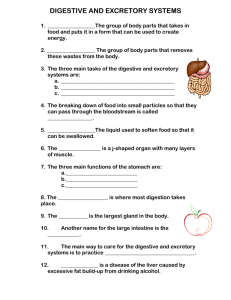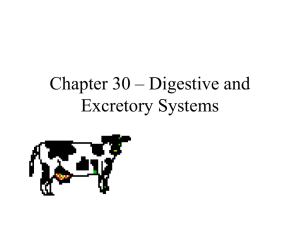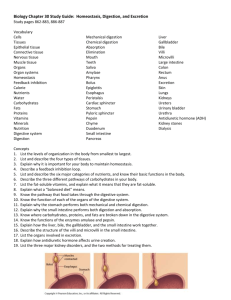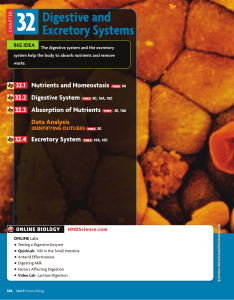Biology Reading Notes Outline Name:__________________________________________________ Chapter 30: Digestive and Excretory Systems
advertisement
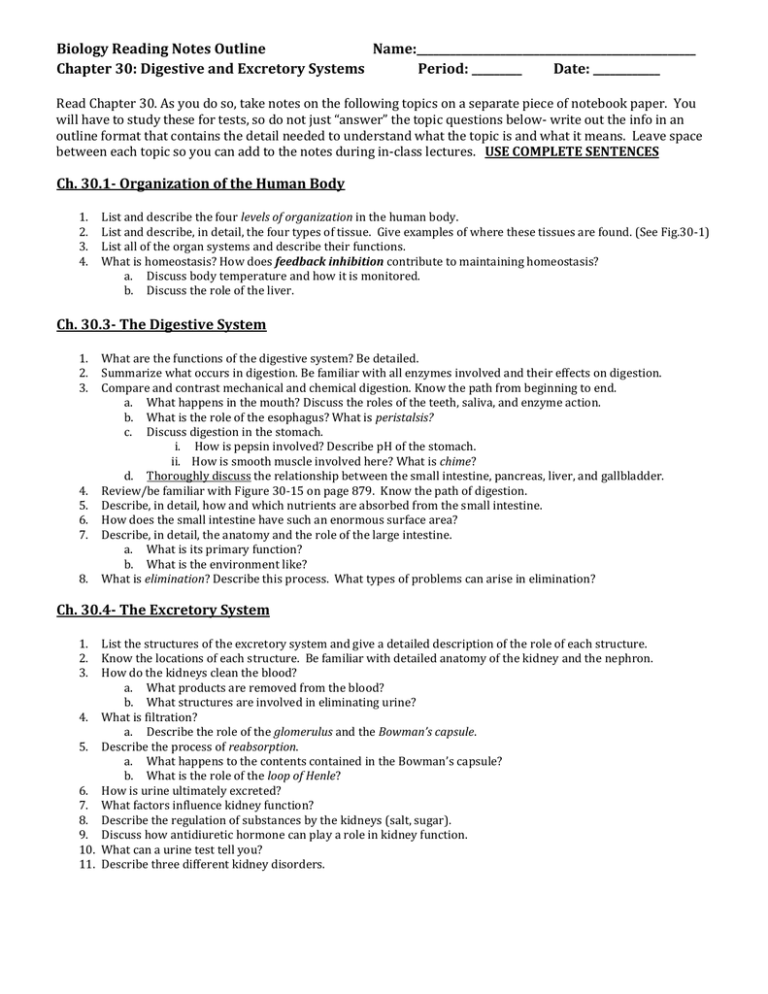
Biology Reading Notes Outline Name:__________________________________________________ Chapter 30: Digestive and Excretory Systems Period: _________ Date: ____________ Read Chapter 30. As you do so, take notes on the following topics on a separate piece of notebook paper. You will have to study these for tests, so do not just “answer” the topic questions below- write out the info in an outline format that contains the detail needed to understand what the topic is and what it means. Leave space between each topic so you can add to the notes during in-class lectures. USE COMPLETE SENTENCES Ch. 30.1- Organization of the Human Body 1. 2. 3. 4. List and describe the four levels of organization in the human body. List and describe, in detail, the four types of tissue. Give examples of where these tissues are found. (See Fig.30-1) List all of the organ systems and describe their functions. What is homeostasis? How does feedback inhibition contribute to maintaining homeostasis? a. Discuss body temperature and how it is monitored. b. Discuss the role of the liver. Ch. 30.3- The Digestive System 1. 2. 3. 4. 5. 6. 7. 8. What are the functions of the digestive system? Be detailed. Summarize what occurs in digestion. Be familiar with all enzymes involved and their effects on digestion. Compare and contrast mechanical and chemical digestion. Know the path from beginning to end. a. What happens in the mouth? Discuss the roles of the teeth, saliva, and enzyme action. b. What is the role of the esophagus? What is peristalsis? c. Discuss digestion in the stomach. i. How is pepsin involved? Describe pH of the stomach. ii. How is smooth muscle involved here? What is chime? d. Thoroughly discuss the relationship between the small intestine, pancreas, liver, and gallbladder. Review/be familiar with Figure 30-15 on page 879. Know the path of digestion. Describe, in detail, how and which nutrients are absorbed from the small intestine. How does the small intestine have such an enormous surface area? Describe, in detail, the anatomy and the role of the large intestine. a. What is its primary function? b. What is the environment like? What is elimination? Describe this process. What types of problems can arise in elimination? Ch. 30.4- The Excretory System 1. 2. 3. List the structures of the excretory system and give a detailed description of the role of each structure. Know the locations of each structure. Be familiar with detailed anatomy of the kidney and the nephron. How do the kidneys clean the blood? a. What products are removed from the blood? b. What structures are involved in eliminating urine? 4. What is filtration? a. Describe the role of the glomerulus and the Bowman’s capsule. 5. Describe the process of reabsorption. a. What happens to the contents contained in the Bowman’s capsule? b. What is the role of the loop of Henle? 6. How is urine ultimately excreted? 7. What factors influence kidney function? 8. Describe the regulation of substances by the kidneys (salt, sugar). 9. Discuss how antidiuretic hormone can play a role in kidney function. 10. What can a urine test tell you? 11. Describe three different kidney disorders.
